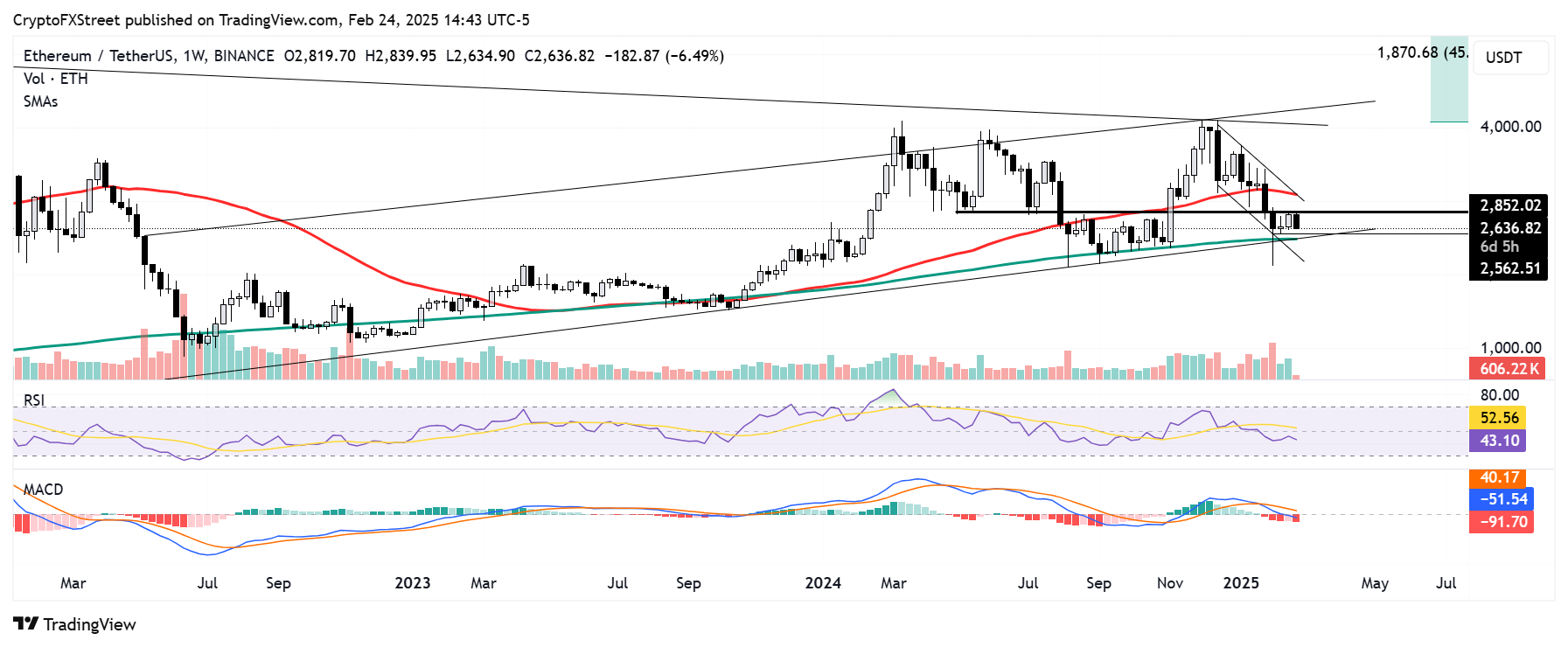Ethereum Price Forecast: Hackers show preference for ETH as Bybit buying pressure fails to fuel demand
Ethereum price today: $2,640
- Bybit's buying activity to close the gap in its Ethereum reserve failed to boost ETH demand.
- QCP analysts note that Lazarus Group's over 400,000 ETH stolen from Bybit won't cause a supply overhang on Ethereum.
- Hackers swapped stolen Infini stablecoins for 17,696 ETH.
- ETH has to hold an ascending channel's lower boundary support to maintain a long-term bullish structure.
Ethereum (ETH) is down 5% on Monday as recent crypto hacks show that hackers are developing a strong interest in the top altcoin. Additionally, bearish sentiment from a potential supply overhang by the Lazarus Group scaled down demand from Bybit's efforts to cover its reserve gap.
Ethereum may not face supply overhang from Lazarus Group's stolen ETH
Bybit CEO Ben Zhou confirmed in an X post on Monday that the exchange has 100% closed the reserve gap from its hack on Friday, where the North Korean Lazarus Group stole about $1.44 billion worth of ETH.
The gap was closed through loans, whale deposits and over-the-counter (OTC) ETH purchases.
Despite Bybit's buying activity expanding demand, ETH's price remained subdued by bearish sentiment, down over 5% in the past 24 hours.
The negative sentiment stems from the huge supply of ETH that sits in the hands of Lazarus Group due to the hack. The hackers are now the 14th largest ETH holders, with 0.42% of the top altcoin's total supply.
As a result, most investors are exercising caution, considering the hackers could flood the market with selling pressure if they decide to cash out their holdings.
However, QCP analysts highlighted a different view in a note to investors on Monday, stating that the hackers hold on to tokens for years before laundering them.
"On-chain data shows that funds from past hacks remain untouched, effectively creating their very own strategic reserve," the analysts wrote.
“History has shown that despite persistent fears of random sell pressure, crypto has grown increasingly resilient as the market learns and adapts. Given Friday's muted reaction in price and vols, along with modest funding levels, any further downside moves should remain limited for now," they added.
Meanwhile, attackers hacked stablecoin bank Infini for $49.5 million USDC and converted the stolen funds to DAI, which was used to purchase 17,696 ETH.
The recent hacks highlight a growing trend where hackers are showing a preference for ETH.
Ethereum Price Forecast: Bulls need to defend an ascending channel's lower boundary
Ethereum saw $72.85 million in futures liquidations in the past 24 hours, per Coinglass data. The total amount of liquidated long and short positions accounted for $59.71 million and $13.14 million, respectively.
ETH continued trading in a long-term ascending channel on Monday after seeing a rejection near the $2,850 level last week. Bears have dominated the top altcoin since holding the channel's upper boundary resistance on December 16.

ETH/USDT weekly chart
The bearish trend was accelerated after ETH declined below the 50-day Simple Moving Average (SMA) and $2,850 in the first week of February.
While bears dominate in the short term, ETH still maintains a slightly bullish structure in the long term.
However, bulls must defend the channel's lower boundary support strengthened by the 100-day SMA to maintain the bullish structure and enable ETH to overcome the $2,850 critical resistance.
A reclaim of the $2,850 level could send ETH above a descending trendline and the 50-day SMA, sparking a potential rally toward the channel's upper boundary.
Meanwhile, ETH could find support near $2,560 in the short term.
The Relative Strength Index (RSI) and Stochastic Oscillator (Stoch) are below their neutral levels, indicating dominant bearish momentum.
A weekly candlestick close below the ascending channel's lower boundary line will invalidate the thesis.
Ethereum FAQs
Ethereum is a decentralized open-source blockchain with smart contracts functionality. Its native currency Ether (ETH), is the second-largest cryptocurrency and number one altcoin by market capitalization. The Ethereum network is tailored for building crypto solutions like decentralized finance (DeFi), GameFi, non-fungible tokens (NFTs), decentralized autonomous organizations (DAOs), etc.
Ethereum is a public decentralized blockchain technology, where developers can build and deploy applications that function without the need for a central authority. To make this easier, the network leverages the Solidity programming language and Ethereum virtual machine which helps developers create and launch applications with smart contract functionality.
Smart contracts are publicly verifiable codes that automates agreements between two or more parties. Basically, these codes self-execute encoded actions when predetermined conditions are met.
Staking is a process of earning yield on your idle crypto assets by locking them in a crypto protocol for a specified duration as a means of contributing to its security. Ethereum transitioned from a Proof-of-Work (PoW) to a Proof-of-Stake (PoS) consensus mechanism on September 15, 2022, in an event christened “The Merge.” The Merge was a key part of Ethereum's roadmap to achieve high-level scalability, decentralization and security while remaining sustainable. Unlike PoW, which requires the use of expensive hardware, PoS reduces the barrier of entry for validators by leveraging the use of crypto tokens as the core foundation of its consensus process.
Gas is the unit for measuring transaction fees that users pay for conducting transactions on Ethereum. During periods of network congestion, gas can be extremely high, causing validators to prioritize transactions based on their fees.

